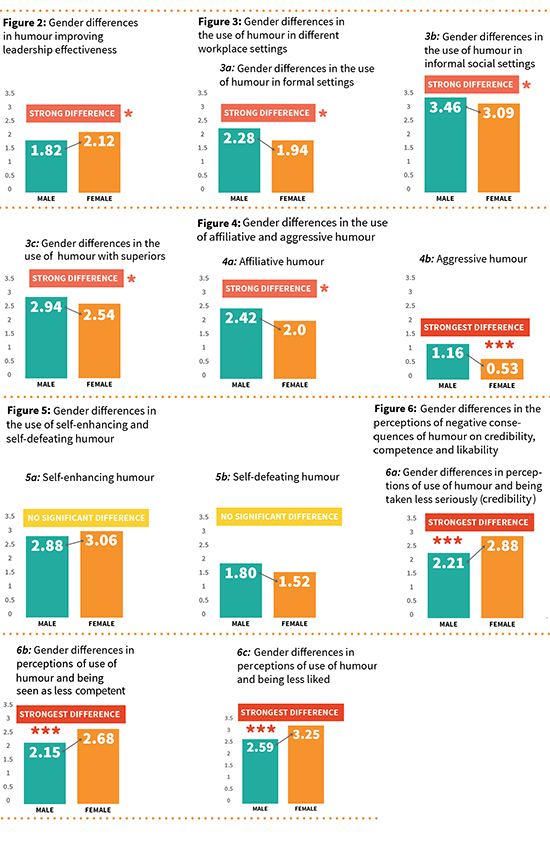By Vanessa Marcié and Sucheta Nadkarni
While humour can serve as a key to improve work culture and leadership effectiveness, there is a good chance that you are not cracking jokes properly or in a strategic manner, which can be damaging on many levels. The authors present their study on what makes for an effective humour at the workplace based on their interviews with successful female and male leaders from a wide range of industries.
I think you should take your job seriously, but not yourself. That is the best combination.
– Dame Judi Dench
A sense of humor is part of the art of leadership, of getting along with people, of getting things done.
– Dwight Eisenhower
The use of humour at the workplace gets mixed reviews. While humour can create positive energy in teams and help to improve leaders’ likability, humour can also destroy a manager’s credibility, prevent them from being taken seriously and offend people. Yet how do male and female leaders use humour differently in the workplace? In a study conducted at Cambridge Judge Business School, we found that women often hold back in using humour even when it may be effective – and this represents a major lost opportunity for women to become effective leaders.
The issue of whether male and female leaders use humour differently in the workplace is an important question because studies have shown that men and women differ in their leadership styles. So we sought to identify how and why humour and gender are linked at the workplace.
To answer these key questions, we conducted two studies. The first was a survey-based study of 100 middle and senior executives to identify the broad patterns of differences in how males and females use humour in workplace settings. In the second study, we built on these findings and interviewed successful female and male leaders about the humour strategies they use in enhancing their leadership. These studies indicate that gender differences are central to understanding the link between humour and leadership, and provide food for thought on how female leaders can better use humour strategically to become successful leaders.
[ms-protect-content id=”9932″]
Humour and leadership: Key concepts
There are two broad areas in understanding how executives use humour in their workplace: the sort of work settings where executives use humour, and the types of humour executives choose to use in their workplace interactions.
Work settings. Executives interact with peers, subordinates and superiors in different settings, both formal and informal. These formal and informal settings are potential avenues where leaders can use humour. However, executives vary in their comfort in using humour in these different work settings. Some executives tend to use humour broadly in most or all of their formal as well as informal interactions, while others use humour more carefully in selective informal settings. We examine three avenues of workplace settings where male and female leaders choose to use humour: Formal committees and meetings, informal social gatherings, and one-on-one meetings with colleagues.
Types of Humour. Research has identified four styles that capture both the positive and negative sides of humour.
- Self-enhancing humour involves being able to laugh at yourself, including a joking reference to something bad that has occurred in your life. This often entails trying to find the humour in everyday situations, and making yourself the target of the humour in a good-natured way through expressions such as “Maybe I just don’t quite get it.”
- Affiliative humour involves jokes about everyday occurrences that many people can find funny, and this type of humour aims to bring people together through the sharing of mundane humourous matters.
- Aggressive humour includes put-downs of individuals or groups, which can take the form of bullying if used to threaten or harm psychologically.
- Self-defeating humour involves criticising yourself, and is often used to preemptively avoid attacks by making oneself the butt of jokes.
Study one: Survey study
We used a snowball sampling method to conduct the survey. We started with Executive MBA students enrolled in a major university who then referred us to other acquaintances. Of the 168 we approached, 100 middle and senior executives completed the survey (a 60 percent response rate). Our sample consisted of 68 (67 percent) males and 33 (33 percent) females (fig. 1a). Middle and senior executives of large public limited companies (> 5000 employees) constituted 36 percent, and founders of small start-ups (1-50 employees) comprised 19 percent of the total sample (fig. 1b). The participants belong to a wide range of industries (fig. 1c) including finance, IT, and healthcare, among others. The survey was carefully designed using established scales of the four humour styles, and customised items for humour in different workplace settings were developed through pilot testing. Each question was rated on a 1 – 5 point scale.
Summary of main survey results: Gender differences in humour and leadership
We examined gender differences in humour and leadership using the t-test* and found significant differences between male and female leaders with regards to humour styles, workplace settings and the use of humour in making them better leaders. Here are the key findings:
•Humour and leadership effectiveness. Females believe much more than males that humour helps them lead better (fig. 2).
•Workplace settings. Male executives use humour more in formal settings, (fig. 3a) more in informal social settings (fig. 3b), and much more with superiors (fig. 3c) – compared to female counterparts.
•Humour styles. Male executives use affiliative humour (fig. 4a) and aggressive humour (fig. 4b) much more than female executives do.
•No significant gender differences.Both male and female executives avoid self-defeating humour (fig. 5a) at the workplace, while both male and female executives use self-enhancing humour (fig. 5b) considerably at the workplace.
Implications of the survey study:
What do the survey study results tell us? We found an inherent gender contradiction in humour and leadership. Female executives believed much more than male counterparts that humour helps them lead better. Yet female executives use less humour in both formal and informal settings in the workplace, and also use humour less frequently with superiors. Thus, female executives seem to avoid using humour in the workplace despite their belief that it can help in making them better leaders.
When asked about whether there is a double standard for humour, females believed more than males that women leaders using humour are taken less seriously (fig. 6a), are less well-liked (fig. 6c), and are seen as less competent (fig. 6b).
These results suggest that the fear of a double standard may be holding female leaders back from using humour strategically in becoming effective leaders.
Study two: Qualitative interview study
Following the survey study, we conducted in-depth semi-structured qualitative interviews with 14 middle and senior executives (eight females and six males) from large public limited companies to founders of small start-ups. They work in the finance, technology, healthcare, energy and tobacco industries. The main question we sought to answer was: How can you use humour to unleash leadership effectiveness? Following the descriptive results in study one, we wanted to move to prescription with the question: How can leaders (both male and female) use humour strategically to become better leaders? We used in-depth qualitative interviews with successful male and female leaders to identify some key considerations for including humour in the leadership toolkit.
Know your audience. It is critical for leaders to know the audience including their work backgrounds, basic personal information and their affiliations. Knowing the audience can help leaders minimise the risks associated with the use of humour such as offending peers, appearing insensitive and being socially distanced at the workplace. In today’s LinkedIn and Facebook age, it is quite easy to get this information. The better you know the audience, the better you can customise self-enhancing and affiliative humour, and the more you can avoid well-intentioned self-enhancing or affiliative jokes turning into unintentionally aggressive or self-defeating humour disasters. Regardless of the humour style you use, knowing your audience can help you better connect with your audience and focus on commonalities in bringing people together. In this regard, a female project leader of a major European aircraft manufacturing company stated:
“Create a connection with your audience. While preparing your jokes, think of what you have in common with your audience. Avoid risky topics such as politics or religion. It is also important to own your joke: once it’s out there, it’s out there. If it works, everybody will laugh and if it doesn’t, well, just say: ‘ I’m sorry’ and move on.”
Be mindful of laughing at others. Avoid aggressive humour that is insulting to others and can subject peers and colleagues at work to negative psychological effects such as frustration, anger and sadness. Aggressive humour can socially distance leaders in workplace settings and create conflicts and animosity. Instead, focus on affiliative humour that brings people together and creates positive energy. A female founder of a small finance company said:
“Humour should be something that brings the team together, rally the troops to get through difficult periods. We should try to be kind as much as possible in our organisations and especially if we are managing people. Organisational humour should be kind and intelligent in using situational awareness. For example, you can look at different customer stereotypes or things that might happen within the value chain and you can draw comedy from it.”
Laugh at yourself instead. Humour can be powerful for leaders in downward management.Using self-enhancing and self-defeating humour can enhance the psychological safety of peers and subordinates in being open and talking freely with leaders about their concerns. When leaders show their own vulnerabilities to subordinates, they reduce feelings of intimidation and improve their likeability among those employees; this can make subordinates feel more comfortable in admitting their own mistakes, expressing their concerns and challenging the leaders, all of which can enhance performance. A male CFO of a Canadian smart kitchen product company stated:
“I think humour is effective when you are getting things done. And, along the way, you show that you’re not taking yourself too seriously; that we just can stop and have a good laugh together. From a leadership position, self- deprecating humour is really good, it helps subordinates know that you’re a real person and you realise your flaws.”
Although very effective in interacting with subordinates, self-defeating humour may create unnecessary risks in interactions with superiors and peers, so it is important to avoid self-defeating humour in these settings.
Appear in control. Use jokes to illustrate or highlight a key point, but avoid telling jokes just to be funny all the time. Joking for its own sake can make executives look unprofessional and not taken seriously. An attorney of a major American law firm describes how less is more:
“People who come across as very serious when they say something that’s funny are far more impactful than the person who jokes around all the time. So, if your style is to be quiet and understated, you can still be very funny and have an even bigger impact if you just choose those very few well-timed moments to make it happen.”
A regional director of a large UK-based mortgage company reinforced the importance of using humour to show that you are authentic and in control even under pressure:
“If you are under pressure, humour is the first thing that can disappear. So if you can still use it while under pressure, it conveys the message that you are in control of yourself and the situation.”
Be ready. Women can encounter sexual remarks or inappropriate comments about physical appearance. Our interviewees recommended being well-prepared with a pointy joke that helps convey the inappropriateness of the remarks and embarrass the person cracking the joke without being combative. In this regard, an attorney of a major American law firm advises women to be ready with a funny comeback for these uncomfortable situations:
“If you have a ready comeback in your pocket, it’s a really good way to point out something that’s inappropriate without coming across as the bitchy feminist.”
If used appropriately, humour can be a critical tool in enhancing leadership effectiveness. Yet women leaders seem to hold back from using humour in their interactions in the workplace, and this is a major lost opportunity in becoming better leaders. Suggestions yielded by our qualitative interviews can help female leaders become more confident about using humour strategically in becoming better leaders.
[/ms-protect-content]About the Authors
 Vanessa Marcié is Vice-President Business Development France for London and Partners and co-founder/Director of Cambridge Consulting Group, a boutique management consulting firm. She holds an MBA from Cambridge Judge Business School and a PhD from Côte d’Azur University. As a business professional, academic and standup comedian she researches the benefits of humour in leadership.
Vanessa Marcié is Vice-President Business Development France for London and Partners and co-founder/Director of Cambridge Consulting Group, a boutique management consulting firm. She holds an MBA from Cambridge Judge Business School and a PhD from Côte d’Azur University. As a business professional, academic and standup comedian she researches the benefits of humour in leadership.
 Sucheta Nadkarni is the Sinyi Professor of Chinese Management and Director of Wo+Men’s leadership centre at the University of Cambridge, Judge Business School. Her research centres on strategic leadership with a special focus on gender issues in senior leadership. She is an associate editor at the Academy of Management Journal.
Sucheta Nadkarni is the Sinyi Professor of Chinese Management and Director of Wo+Men’s leadership centre at the University of Cambridge, Judge Business School. Her research centres on strategic leadership with a special focus on gender issues in senior leadership. She is an associate editor at the Academy of Management Journal.
References
1. Bitterly, T. B., Brooks, A. W., & Schweitzer, M. E. (2016, November 10). “Risky Business: When Humor Increases and Decreases Status.” Journal of Personality and Social Psychology. Advance online publication. http://dx.doi.org/10.1037/pspi0000079
2. Eagly, Alice H., and Linda L. Carli. “The female leadership advantage: An evaluation of the evidence.” The leadership quarterly 14.6 (2003): 807-834.
3. Eagly, Alice H. “Female leadership advantage and disadvantage: Resolving the contradictions.” Psychology of women quarterly 31.1 (2007): 1-12.
4. Ho, L.-H. et al. (2011) “Influence of humorous leadership at workplace on the innovative behavior of leaders and their leadership effectiveness.” African Journal of Business Management, 5(16), pp. 6674-6683. doi: 10.5897/AJBM10.1087.
5. Kai Chi Yam, Michael Christian, Wu Wei, Zhenyu Liao, J. N. (2017) “The mixed blessing of leader sense of humor: Examining costs and benefits.”Academy of Management Journal. Research Collection Lee Kong Chian School of Business. Available at: http://ink.library.smu.edu.sg/cgi/viewcontent.cgi?article=1030&context=lkcsb_research_all
6. Katz, J. 1996. “Families and funny mirrors: A study of the social construction and personalembodiment of humor.” American Journal of Sociology, 101, 1194-1237
7. Malone, P. B. 1980. “Humor: A double-edged tool for today’s managers?” Academy of
Management Review, 5(3): 357-360
8. Martin, R. A. et al. (2003) “Individual differences in uses of humor and their relation to
psychological well-being: Development of the Humor Styles Questionnaire.” Journal of
Research in Personality, 37, pp. 48-75. Available at: www.elsevier.com/locate/jrp
9. Morreall, J. Humor and work. Humor, 1991, 4, 359-73.
10. Clouse, R. W.&Spurgeon, K. L. 1995. “Corporate analysis of humor.” Psychology: A Quarterly Journal of Human Behavior, 32(3-4): 1-24.
10. Riggio, R.E. (2015). “The 4 styles of humor. What do you find funny? How do you use humor?” Psychology Today. Available at: www.psychologytoday.com/us/blog/cutting-edge-leadership/201504/the-4-styles-humor
11. Romero, E. J. and Cruthirds, K. W. (2006) “The Use of Humor in the Workplace ExecutiveOverview.” Available at: www.emotionsnet.org/wp-content/uploads/2011/04/RomeroCruthirds2006.pdf






































